
still need the March edition?
![]() .Events .Moon .Planets .Minor Planets, NEOs .Comets .Shooting Stars .Occultations .Sun .check more! (occultations observers are advised to check in 'Events', and to turn to such dedicated sites like the I.O.T.A).
.Events .Moon .Planets .Minor Planets, NEOs .Comets .Shooting Stars .Occultations .Sun .check more! (occultations observers are advised to check in 'Events', and to turn to such dedicated sites like the I.O.T.A). ![]() Caution! According to our policy, our site is passing now DST for the northern hemisphere and ST for the southern check more details. don't forget to check the weather! For the US: the NOAA . color codes: Wwd worldwide, UsA USA-Americas, EuA Europe-Africa, AsP Asia-Pacific, Chk Check for Your Zone. check the site's concept and the instructions of use
Caution! According to our policy, our site is passing now DST for the northern hemisphere and ST for the southern check more details. don't forget to check the weather! For the US: the NOAA . color codes: Wwd worldwide, UsA USA-Americas, EuA Europe-Africa, AsP Asia-Pacific, Chk Check for Your Zone. check the site's concept and the instructions of use
![]()
 Editor's Choice Fine Picture
Editor's Choice Fine Picture ![]() Editor's Choice Sky At
Editor's Choice Sky At ![]()
![]()
![]() Tech News
Tech News ![]() color codes: Wwd worldwide, UsA USA-Americas, EuA Europe-Africa, AsP Asia-Pacific, Chk Check for Your Zone. check the site's concept and the instructions of use
color codes: Wwd worldwide, UsA USA-Americas, EuA Europe-Africa, AsP Asia-Pacific, Chk Check for Your Zone. check the site's concept and the instructions of use
| Tweet |
.Events Seen All Month Long .Ephemerides Proper
(data from the former yearly ephemerides generator at Fred Espenak's NASA's eclipse website; miscellaneous data with the 'Astronomical Phenomena for The Year 2017,' a joint work by the United Kingdom Hydrographic Office and the U.S. Naval Observatory; to be found at the latter's site; all time UT except otherwise stated)
Wwd Mars and Saturn are moving relatively to eachother in the morning sky, between Apr. 1-15, with a remarkable closest of 1 degree 30 minute reached by about Apr. 3. The show will occur among the fields of Sagittarius, the Archer. Fine visual and photographic opportunities as Moon will come to add
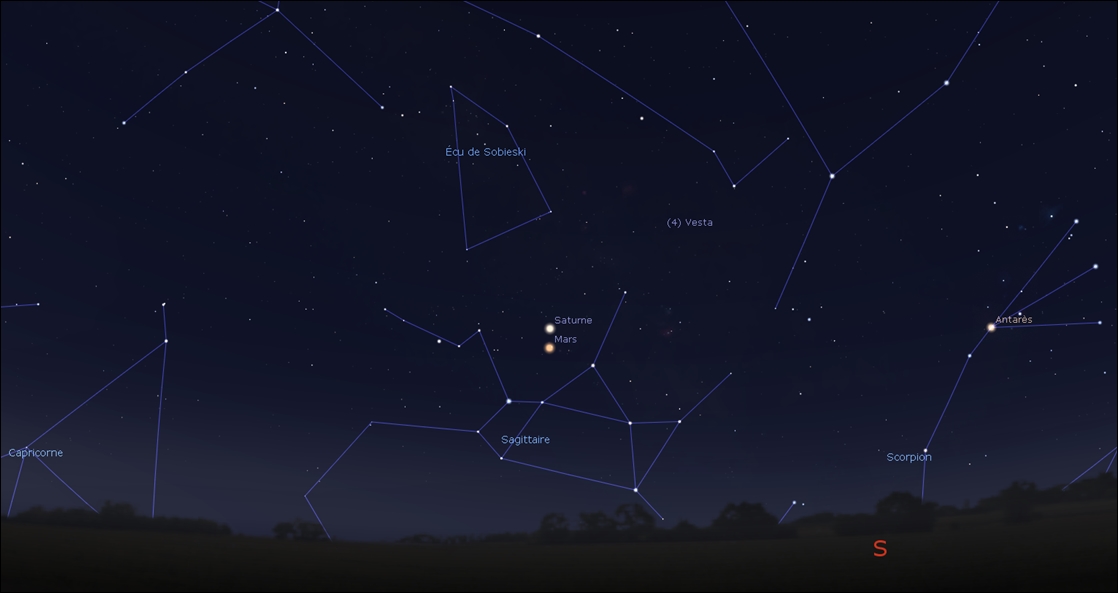 | Mars and Saturn moving relatively to eachother, with a remarkable closeness! Fine visual and photographic opportunities! picture site 'Amateur Astronomy' based upon Stellarium |
3 Wwd Waning gibbous Moon, at the Tropics and the southern hemisphere only, is seen close to Jupiter tonight
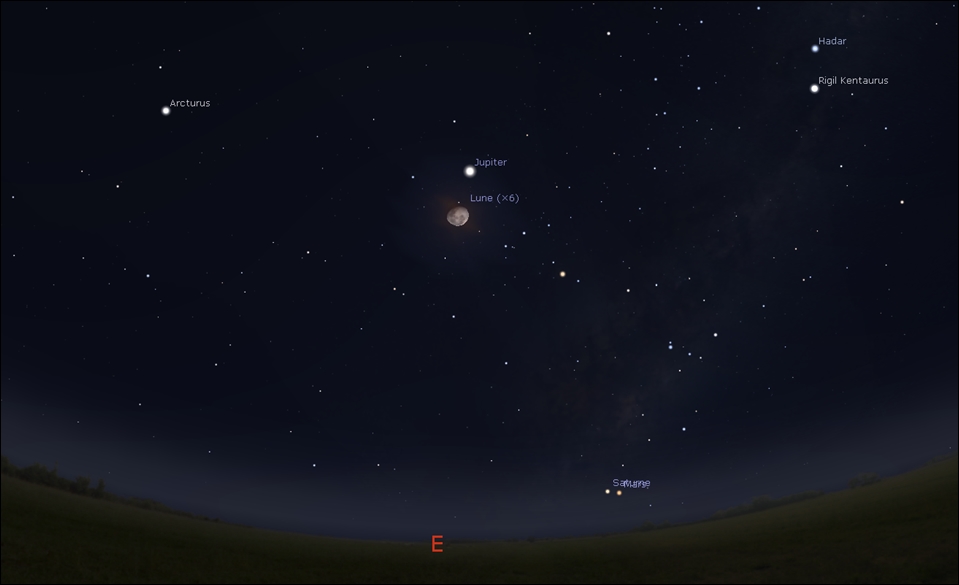 | Moon close to Jupiter at the Tropics and the southern hemisphere! picture site 'Amateur Astronomy' based upon Stellarium |
6 Wwd Tomorrow morning by dawn, last quartered Moon is seen close to Saturn as Mars is not that far, where both are seen like morning stars. Fine visual and photographic opportunities. The show is seen by in the night for the Tropics and the southern hemisphere
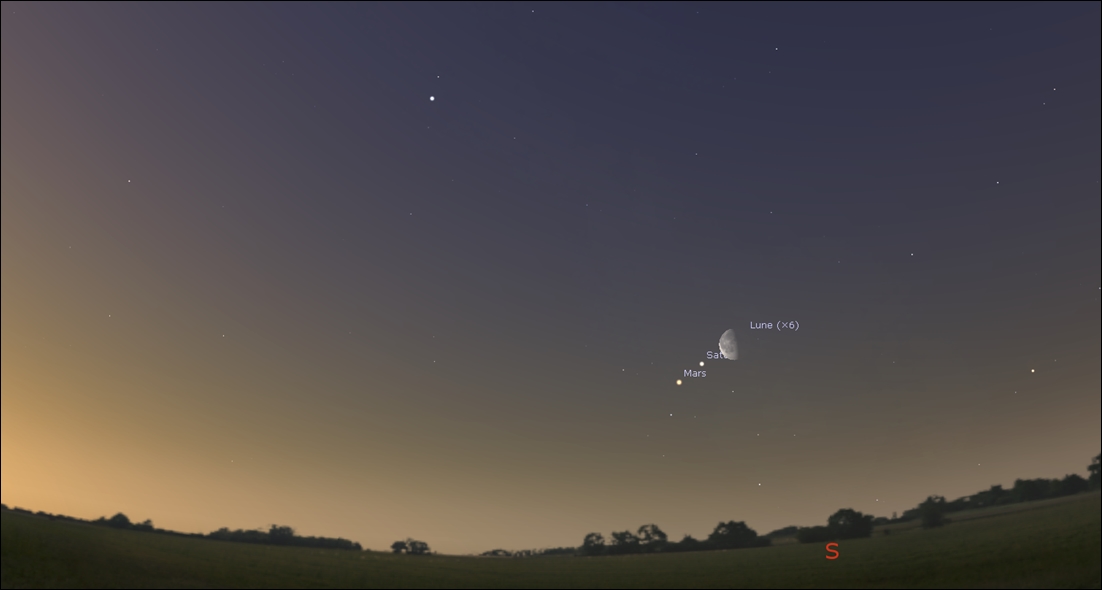 | Moon, where both planets available like morning stars, close to Saturn as Mars not that far! The show is seen by night elsewhere picture site 'Amateur Astronomy' based upon Stellarium |
7 (1) Wwd Tomorrow morning by dawn, last quartered Moon is seen close to Mars as Saturn is not that far, where both are seen like morning stars. Fine visual and photographic opportunities. The show is seen by in the night for the Tropics and the southern hemisphere
7 (2) Wwd Moon reaches a southernmost declination at 14:37 UT
8 Wwd Moon is at its apogee at 05:32 UT (distances non available)
10 Wwd Moon is at a descending node at 08:09 UT
13 Wwd Tomorrow morning, where Mercury available like a morning star, last crescent is seen close! Fine visual and photographic opportunities
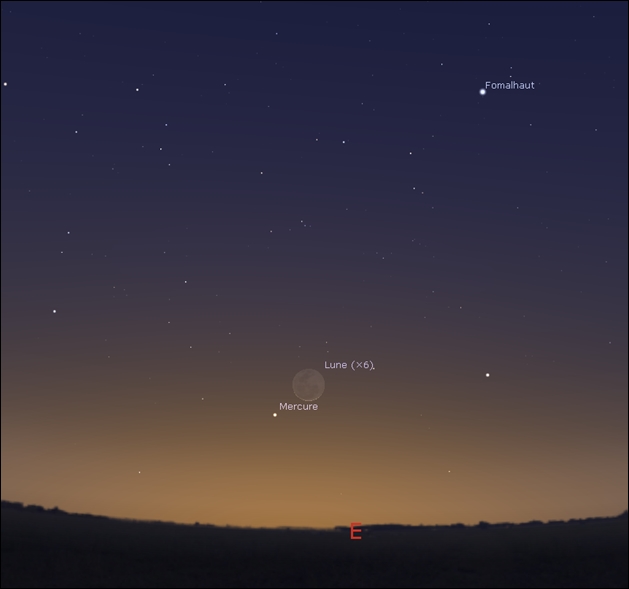 | Where Mercury available like a morning star, Moon is close to it! picture site 'Amateur Astronomy' based upon Stellarium |
16 Wwd The Lyrids shooting stars begin to be active today as they are until April 25, with a peak usually on April 21-22. check more at the date of the peak
17 UsA EuA Very first crescent Moon is seen not that far from Venus, when the latter available like a evening star! Fine visual and photographic opportunities!
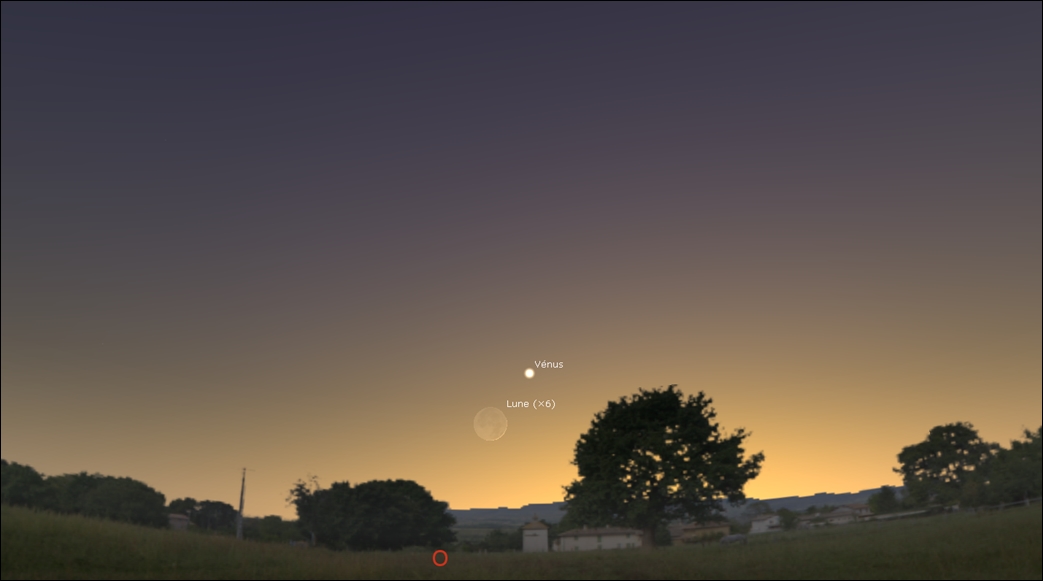 | Moon close to Venus when the latter available like a evening star! picture site 'Amateur Astronomy' based upon Stellarium |
18 AsP Very first crescent Moon is seen not that far from Venus, when the latter available like a evening star! Fine visual and photographic opportunities!
19 (1) Wwd The Eta Aquarids shooting stars begin to be active today as they are until May 28. A important shower they are best viewed from the southern hemisphere check more
19 (2) Wwd There is a occultation of Aldebaran, the bright star to constellation Taurus, the Bull today by Moon! check more at Occultations; check more too at such sites like "The International Occultation Timing Association" (I.O.T.A.)
20 Wwd Moon is at its perigee at 14:44 UT (distances non available)
21 Wwd Moon reaches a northernmost declination at 07:38 UT
22 Wwd The Lyrids shooting stars usually are peaking April 21-22. check more back
23 Wwd Moon is at a ascending node at 12:19 UT
24 (1) Wwd Waxing gibbous Moon at all latitudes, is close to Regulus, the bright star to constellation Leo, the Lion tonight. Fine visual and photographic opportunities!
24 (2) Wwd There is a occultation of Regulus, the bright star to constellation Leo, the Lion today by Moon! check more at Occultations; check more too at such sites like "The International Occultation Timing Association" (I.O.T.A.)
28 Wwd Waxing gibbous Moon at all latitudes, is seen tonight not that far from Spica, the bright star to constellation Virgo, the Virgin
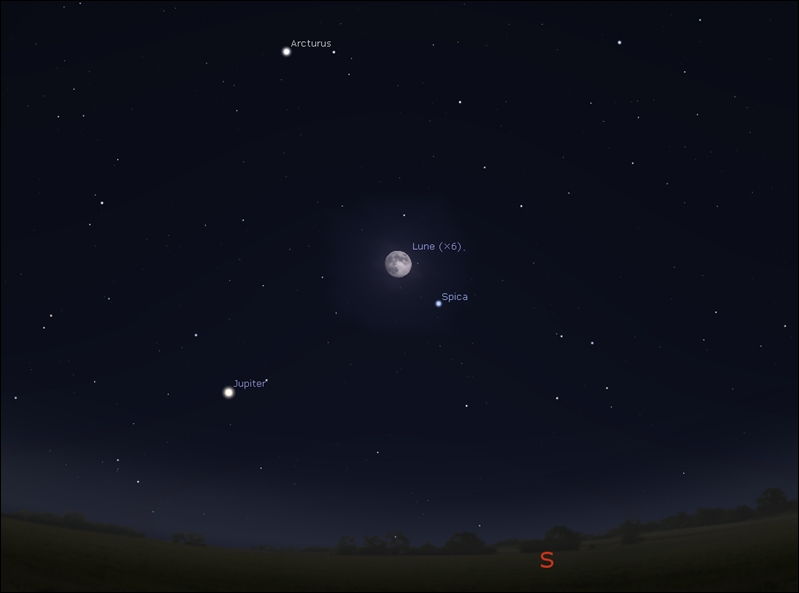 | Moon close to Spica tonight, the bright star to constellation Virgo, the Virgin! picture site 'Amateur Astronomy' based upon Stellarium |
30 Wwd Full Moon tonight, at the Tropics and the southern hemisphere only, is seen close to Jupiter
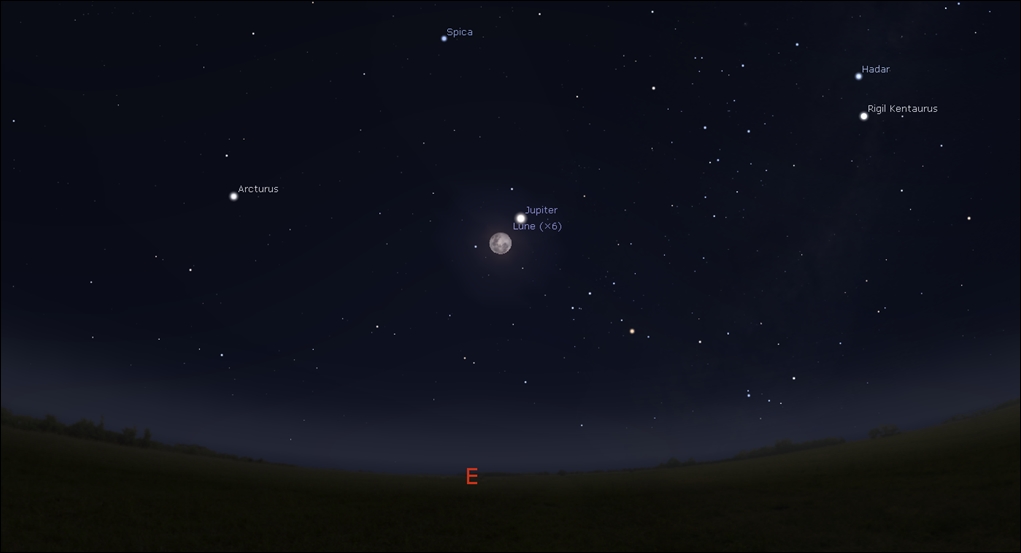 | Moon again close to Jupiter at the Tropics and the southern hemisphere! picture site 'Amateur Astronomy' based upon Stellarium |
Occultations observers are advised to turn to such dedicated sites like the I.O.T.A as they may also check below at our Occultation section
Last Quarter is on April 8th, at 07:18 UT
New Moon is on April 16th, at 01:57 UT
First Quarter is on April 22nd, at 21:46 UT
Full Moon is on April 30th, at 00:58 UT
(source: Ephemeris generator at Fred Espenak's NASA's eclipse website)
Mercury is reaching two remarkable positions by April 2018: a inferior conjunction on Apr. 1 by 17:47, and a greatest western elongation on Apr. 29, by 17:59. Mercury will thus be observable like a morning star since mid-April. The show is null in the northern hemisphere however as it's mean at the Tropics, and interesting in the southern hemisphere!
 | Mercury, a fine morning star in the southern hemisphere! picture site 'Amateur Astronomy' based upon Stellarium |
Venus is now a fine evening star worldwide. It keeps low however in the southern hemisphere
Mars Mars Observation Campaign! is a high morning star, South, in the northern hemisphere. It's about too high at the Tropics to qualify such and is rising there as soon as by 0:14 a.m. local time. That's truer still in the southern hemisphere, with a rise by 11:17 p.m. The Mars Observation Campaign 2018-2019 is now unfolding as it constitutes a remarkable, perihelic opposition, with Mars nearest to Earth at the same time it is nearest to the Sun on its orbit! Mars will reach a 24.2" of apparent diameter at its best as the observation campaign will span from when the Red Planet is reaching, then leaving 6" of apparent diameter! Don't miss those occasions of observing Mars! check more at our Mars Observation Campaign 2018-2019 page
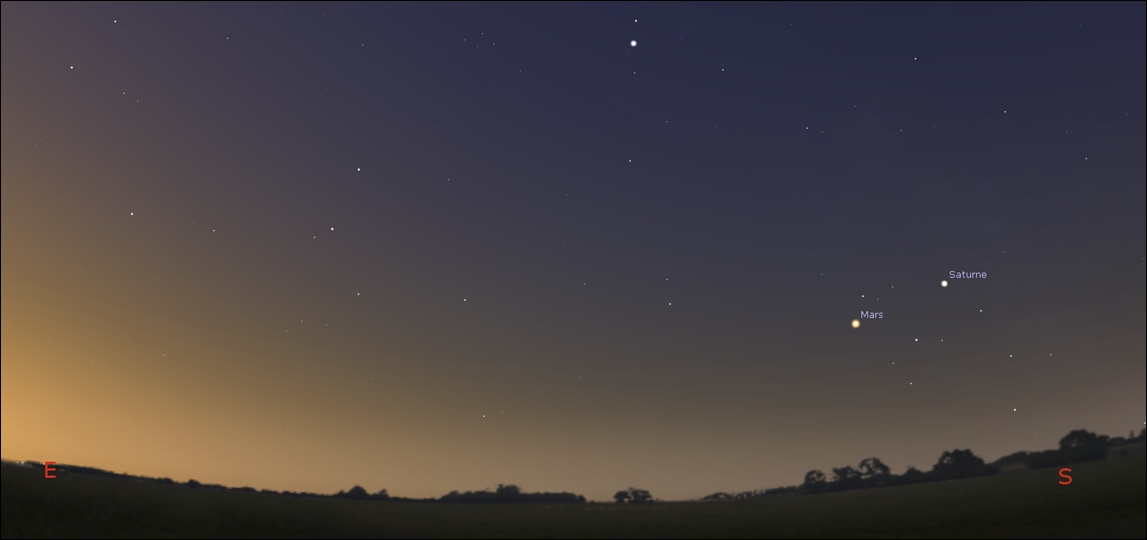 | Mars and Saturn are fine morning stars in the northern hemisphere! picture site 'Amateur Astronomy' based upon Stellarium |
Jupiter Tending to its Best! is tending to its best as the gas giant will reach a opposition next month! Jupiter is rising now by 10:20 p.m. local time in the northern hemisphere, as soon as by 8:20 p.m. at the Tropics, or 7:47 p.m. in the southern hemisphere
 | Jupiter closing to its year's best! picture site 'Amateur Astronomy' based upon Celestia |
Saturn now is a high morning star, South, in the northern hemisphere. It's about too high at the Tropics to qualify such and is rising there as soon as by 11:45 p.m. local time. That's truer still in the southern hemisphere, with a rise by 10:53. A ring maximum aperture had been reached in 2017
Uranus is reaching a conjunction now, on April 18th at 14:35. Uranus thus is seen nowhere worldwide. check more about such a configuration of a planet in our tutorial 'Planets Apparent Motion'
Neptune, after having reached its conjunction last month, keeps unobservable in the northern hemisphere. Neptune by the tropics has returned observable by late night, which is truer still in the southern hemisphere
Pluto now is rising by 2:55 a.m. local time in the northern hemisphere, 11:30 p.m. at the Tropics, and 11:46 in the southern hemisphere. Pluto in 2018 is reaching a rare 'special' opposition as the latter will occur because the planet will reach its orbit's line of node. (according to the International Astronomical Union (IAU) since 2006, Pluto is not considered a planet anymore, but categorized like a dwarf planet instead along with Ceres, Eris, Makemake, and Haumea, and the prototype of a new category of 'trans-Neptunian', 'Pluto-class' objects)
Minor planets are those biggest asteroids in the Asteroid Belt which may be easily observed by amateurs from the Earth, namely Ceres, Pallas, Juno, and Vesta (due to the new categorization by the International Astronomical Union (IAU) by 2006, Ceres belongs to the 5 dwarf planets in the solar system with Pluto, Eris, Makemake, and Haumea). check data and charts at our section Minor Planets on the yearly Calendar page as our tutorial 'Asteroids and Asteroid Hunting' is of help too. Any remarkable event linked to a minor planet may have a notice here below
Some small asteroids dubbed Near-Earth Objects (NEOs) are regularly making close approaches at Earth. People interested in such close approaches may obtain recent and upcoming data at NASA site Near-Earth Object Program (their section "Close Approaches"). Date, miss distance in AU or Lunar Distance (LD), estimated diameter, and relative velocity are available. For further observational purposes, check at the Near-Earth Object Program ephemeris Generator. For more about NEOs see tutorial "
Once every time, the solar system treats us with a remarkable comet, a eery view spanning up to thirty degrees of sky! Most of the time however comets are the domain of dedicated observers as mostly weak and, at the most, hovering at the limit of the naked-eye visibility. A good site to get information about current such comets is the British Astronomical Association Comet Section page or also the Weekly Information about Bright Comets page (which often points to comets close to the visual magnitude). Our 'Comets and Comet Hunting' tutorial will also be helpful. Remarkable comets otherwise usually will be presented below!
->note: shooting stars afficionados will be aware of checking Moon at the dates of the showers
for more about the meteor showers of this month, for possible other meteor showers for this month, and for more about shooting stars, generally, see our tutorial "Shooting Stars"
Each month, Moon occults some relatively bright stars, that is the Moon, beginning either with its bright or its dark visible face, is passing in front of a star. This is called an occultation. The Pleiades, on the other hand, due to their position near the eclipic, are often occulted by Moon too. Some planets, at last, along the year, may be occulted by Moon or they themselves, or their satellites, may be seen too occulting a star. The asteroids too may occult stars. Yearly lists of such phenomenons are to be found at Sky & Telescope/SkyTonight.com, either in their newsstand issues or at their site, as a list of occultations of most brilliant stars, the planets and the Pleiades are available at the I.O.T.A site (I.O.T.A. stands for "The International Occultation Timing Association"). Most notable occultations are signaled below
Aldebaran back, the bright star to constellation Taurus, the Bull is occulted by Moon on Apr. 19th, 2018 by 05:00 UT! The show is available for most of Uzbekistan, most of Kazakhstan, central and northern Russia, north and eastern Scandanavia, N. Greenland, and northernmost Canada . check more at such sites like "The International Occultation Timing Association" (I.O.T.A.)
Regulus back, the bright star to constellation Leo, the Lion is occulted by Moon on Apr. 24th, 2018 by 20:00 UT! The show is available for central Russia and the N.E. tip of Kazakhstan. check more at such sites like "The International Occultation Timing Association" (I.O.T.A.)
check on this site for more about occultations, theoretically
| CAUTION! OBSERVING THE SUN IS DANGEROUS AND REQUIRES DEDICATED SAFE TECHNIQUES! |